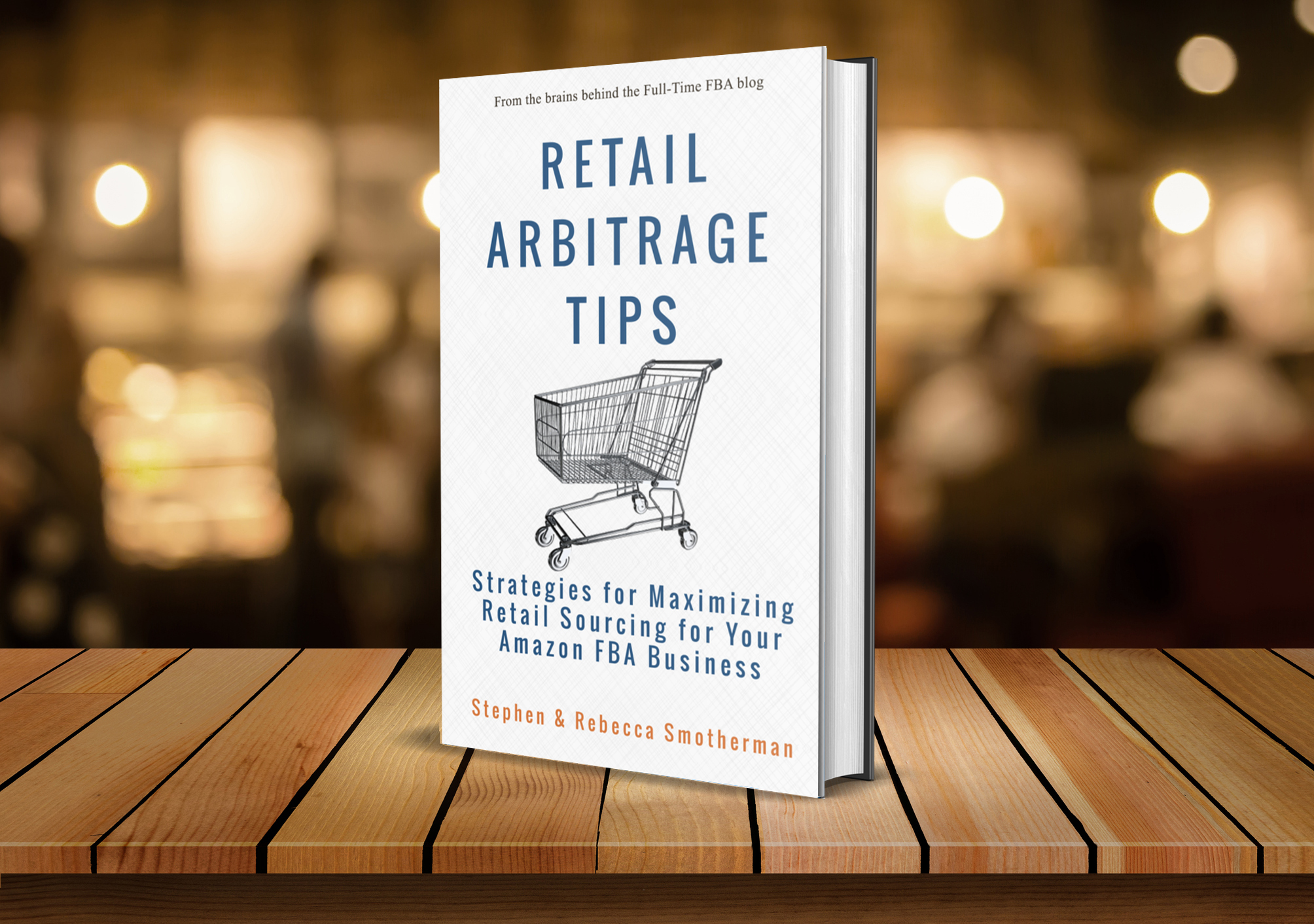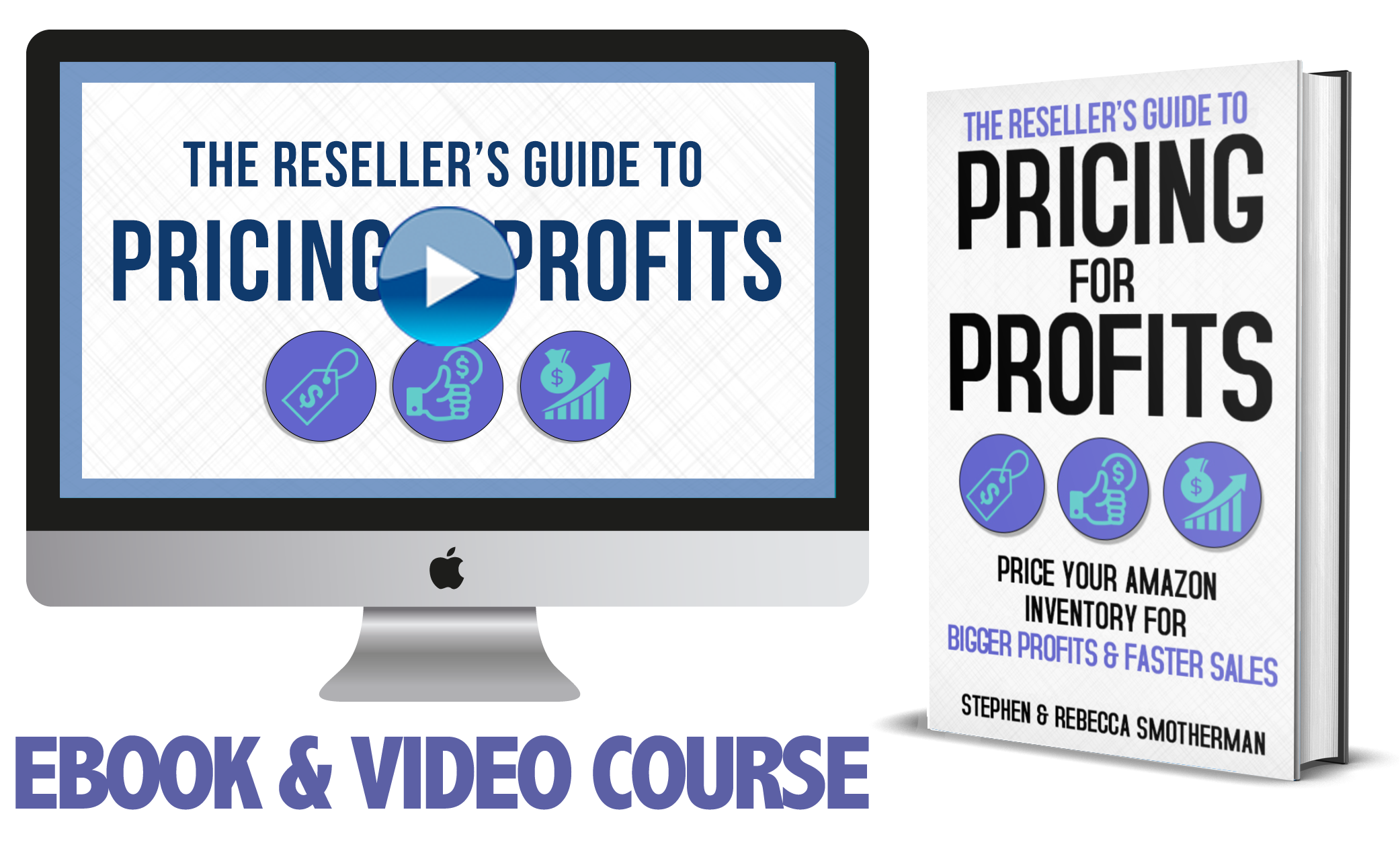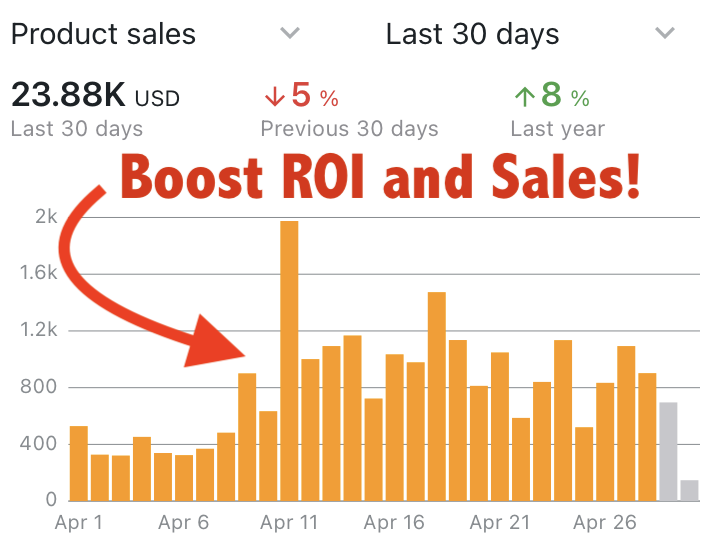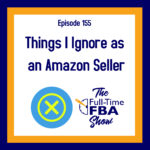Usually on The Full-Time FBA Show, we give you advice on things to focus on in your Amazon FBA journey, but today we are going to speak about all the things that are far better for you when you ignore them.
We start off the show focusing on what to ignore while you’re sourcing for profitable inventory to sell on Amazon. There are a few things you need to ignore that will both help you find more inventory to sell, as well as avoid buying items that won’t sell very well. On top of all the sourcing issues we suggest ignoring, we also walk you through pricing and repricing strategies that are wise to not pay any attention to so that you can make more money with the items you’re selling.
Finally, we close by putting our heads together (see what we did there?) on certain things to ignore in your Amazon business in order to protect you overall business mindset. Doin’t ignore today’s episode — be sure to listen today.
Listen on the podcast player below.
Like what you hear? Tell a friend… and be sure to leave us a rating and a review. Here’s how.
Key points from Episode 155:
 Eight things to ignore as an Amazon seller that will make you more profits, save you time, and protect your mindset.
Eight things to ignore as an Amazon seller that will make you more profits, save you time, and protect your mindset.- Why you should ignore product reviews while sourcing.
- Ignoring certain inventory items to avoid competing with Amazon.
- The importance of basing your price on data and not on what your competitors are doing.
- Why it’s not worth paying attention to Amazon’s pricing suggestions — what to do instead.
- Which sellers to ignore when it comes to repricing.
- Doing away with Amazon restocking suggestions.
- The exact types of social media posts that are not worth your attention.
Links and resources mentioned in this episode:
-

CLICK ON THE ABOVE PIC TO GET YOUR FREE BOOK - Podcast Episode 81 – How Sellers Can Compete Against Amazon and Win the Buy Box!
- Podcast Episode 65 – Is Amazon Trying to Get Rid of Third-Party Sellers?
- Help to Fix Potential Amazon High Price Alerts
- Keepa – Amazon Sales Rank and Price History Tracker
- BQool Automatic Repricer
- Full-Time FBA BQool Review (Plus how to get my personal repricing rules that doubled my sales)
- Understanding Amazon’s IPI Score
Right-click here and save as to download this episode to your computer.
![]()
 The Reseller’s Guide to
The Reseller’s Guide to
Pricing for Profits
Do you have a strategic pricing strategy for the items you’re selling on Amazon? Your pricing game plan can determine whether your Amazon FBA business succeeds or fails.
Amazon (as a seller) has a pricing strategy… and successful third-party sellers have a pricing strategy. It’s about time you had a tactical and calculated pricing strategy that will help take your Amazon business to the next level.
 In The Reseller’s Guide to Pricing for Profits, we’ll help you craft and execute the perfect pricing strategy that will help you increase your profits while still consistently selling your inventory. With this course you’ll be able squeeze more ROI out of every single items in your inventory. With increased profits you’ll be able to grow your Amazon business faster and set yourself up for long-term success.
In The Reseller’s Guide to Pricing for Profits, we’ll help you craft and execute the perfect pricing strategy that will help you increase your profits while still consistently selling your inventory. With this course you’ll be able squeeze more ROI out of every single items in your inventory. With increased profits you’ll be able to grow your Amazon business faster and set yourself up for long-term success.
The course is a combination video course (3+ hours of training) and a 70+ page ebook. The videos and book both share the exact same content (so you can pick the format you most like to learn from). The course also comes with multiple bonuses at no additional charge!
As a special “podcast perk” you can use the coupon code PROFIT at checkout to save $10 off the cost of enrolling in The Reseller’s Guide to Pricing for Profits.
Back to the main page for The Full-Time FBA Show
More Episodes from the Full-Time FBA Show podcast:
Don’t miss an upcoming episode! Subscribe, download episodes, and review the Full-Time FBA Show:
-
-
- Subscribe on iTunes
- Follow on Spotify
- Follow on Amazon Music (or just ask Alexa to “play The Full-Time FBA Show podcast”)
- Follow on iHeartRadio
- Subscribe on Podbean
- Subscribe on Podbay
- Subscribe on Podchaser
-
![]()
Episode 155 Transcript:

[INTRODUCTION]
[0:00:01.8] ANNOUNCER: Welcome to The Full-Time FBA Show. In each episode, it’s our goal to help you turn part-time hours into a full-time income, selling almost anything on Amazon. Now, your hosts of the show, Stephen and Rebecca Smotherman.
[WELCOME]
[0:00:21.3] STEPHEN: Welcome to episode number 155 of The Full-Time FBA Show. Today, we’re going to talk about things to ignore as an Amazon seller. So there’s a lot of stuff that we got to deal with, a lot of stuff we need to think about and we’re going to talk about the stuff you don’t need to worry about thinking about, and to help me talk this through is the one person I will never ignore, my wife, my business partner, Rebecca, what’s up?
[0:00:45.2] REBECCA: I knew that’s how you were going to segue into talking to me, was that you would not ignore me and if you didn’t, I was going to say, “Please don’t ignore me?”
[0:00:52.5] STEPHEN: Oh, yeah. Yeah, if it looks like I’m ignoring you, it’s just because I didn’t hear you or maybe I wasn’t listening, I’m sorry, sometimes that happens.
[0:01:00.0] REBECCA: Yeah, definitely, you have selective hearing when it comes to my voice around the house.
[0:01:04.9] STEPHEN: I don’t know what you’re talking about, let’s move on and talk about this topic today on The Full-Time FBA Show.
[DISCUSSION]
[0:01:14.4] STEPHEN: So, before we get into anything, I just want to let you know, we’ve got a free ebook for you, fulltimefba.com/ratips will give you a free download of our ebook, Retail Arbitrage Tips. It’s our gift to you and by getting that ebook, you will be joining our newsletter and you’ll get some other freebies too. I’m going to keep those other freebies as a surprise but fulltimefba.com/ratips to be a part of our newsletter and get our free ebook, Retail Arbitrage Tips.
[0:01:39.8] REBECCA: So as we get into our topic for today, we want to cover a few different areas of your Amazon business that have some tasks, some items, some mental activities that you might want to ignore. Usually, we are talking on this podcast about things you need to pay attention to but we’re kind of going in a different direction today with things that we ignore. So these things that we ignore when it comes to our Amazon business, can be divided up into three different categories that we’re going to go over throughout the rest of this episode.
Those categories are sourcing decisions, pricing decisions, backend business decisions with your overall Amazon business and then finally, your mindset when it comes to running your business. So, those are the overall categories. Let’s get started first with sourcing. Stephen, what’s the first thing that you would say is good to ignore when it comes to sourcing in your Amazon business?
[0:02:35.3] STEPHEN: Well, the first thing that I like to ignore when it comes to sourcing, at first, it sounds like you know, I’m making a huge mistake by ignoring this, that I’m opening myself up to some horrible things that could happen if I ignore this, but over 10 years of experience selling on Amazon, ignoring this particular sourcing activity is something that’s actually been a big benefit and that activity is ignoring product reviews while sourcing.
I’ve heard a lot of people say, “What do you do if you find a profitable item to sell on Amazon but it’s got horrible reviews? I mean, there’s – I mean, the reviews are just horrible. Am I just, you know, setting myself up for return?” and on the face value that does sound like it’s a possible bad thing to do but again, over 10 years of amazon experience, I ignore product reviews. Why? Because most people, when they leave a product review, they’re complaining.
Most people are going to be leaving complaints, a whole lot more than praise and so even though there’s a lot of negative reviews, I can also see based on the sales rank that it’s still selling. It’s selling a whole bunch and there’s probably a lot of happy customers too that just aren’t leaving positive reviews and overall, yes, I might get a return or two from sourcing an item with a negative review as the, you know, majority reviews but overall, almost all those items sell. So if the item is still selling consistently, I’m still going to source it to sell it on Amazon.
[0:03:58.2] REBECCA: The second area that we would typically ignore when it comes to sourcing in our Amazon business are products that have Amazon as a seller. When Amazon is the seller, we personally tend to ignore those items when we’re trying to look for new inventory. Now, this isn’t always 100% the case, there are times when we will compete with Amazon as a seller but for the most part, we do not like to compete with Amazon, very selective when it comes to that.
The reason for this is that amazon just rarely will share the buy box if they are selling an item. Even if you’re priced near Amazon, they’re not going to share the buy box the same way they would if only third-party sellers were priced near each other and were competing for that buy box. This is especially true when it comes to new books, just don’t even bother trying to compete with Amazon.
You’re not going to be able to sell those items unless people click through and are looking at all the sellers and that rarely happens. Also, Amazon just as typically going to be getting their products that they sell at a super low buy price. They are going to have much better margins than a typical resellers. They buy in such bulk that they’re able to get lower than wholesale prices and let’s be honest, we all know that Amazon is like, not necessarily trying to make their money off of the price of items.
They want to always be the lowest price so they are going to just be really hardcore when it comes to pricing their items low, to sell them, and so you just can’t compete and still make money against them for the most part. There are times that we do compete with Amazon and we’re able to win the buy box and we’re able to win sales. We go over that in our podcast episode number 81, you can check that out at fulltimefba.com/81 for those examples but in general, we tend to ignore products that have Amazon as the seller, when we are sourcing for FBA.
[0:05:50.1] STEPHEN: So the next set of things that we like to ignore are going to fall under the pricing category. So when it comes to pricing, there’s some – a lot of great things to focus on. Here are a few things to ignore. So the third thing overall that we need to ignore as an Amazon seller is to ignore the race to the bottom.
This is a situation where there’s multiple third-party sellers who are selling an item on Amazon and one seller decides to lower their price a few pennies, and another one decides to compete and lower their price of a few pennies, and it just continues to go until it’s a race to the bottom and nobody wins the race to the bottom, so I like to ignore that.
I’m fine with other sellers competing to get the lowest price and to get their sales and when all the other sellers sell out at their lower price and the price stabilizes back up at a higher price, then I actually end up winning the race to the bottom because I did not play in that race at all. So base your pricing decisions based on data, not on what your competition is doing. So just ignore the race to the bottom, most of the time, you’ll come out on top.
[0:06:53.3] REBECCA: The fourth thing we wanted to mention today, also in the pricing category is that we tend to ignore Amazon’s pricing suggestions that they will make it seller-central, and when I say, “tend to ignore” I mean, 100% of the time we ignore Amazon’s pricing suggestions. Amazon is always going to ask you to lower your price.
There’s never going to be going to be a time when Amazon says, “Hey, you might want to raise your price here.” They always want to lower your price and you and I both know that’s not necessarily going to be the best move for the success of your business. Lowering your price is sometimes a good idea and sometimes will lead you to actually get more profits because you’re getting more sales.
But in general, you want to make your pricing decisions based on more information than, “Hey, you could be the lowest price if you lower your price.” So again, make sure you’re pricing based on a lot of data and not just Amazon suggestions and you can get that data from looking at the Keepa graphs.
You can look at the competition that you have in stock that are truly competing with you, those other sellers, all of these are things that you’re going to want to take into account, the time of year that you’re trying to sell this item, so many things and one issue though that does come up is that Amazon might be making pricing suggestions that frees your inventory as stranded inventory because of high price alerts.
That is an issue at times, you want to know how to handle that and you can check out our blogpost on the website, fulltimefba.com/pricealerts will take you to our blog post about how to handle those high priced alerts in the stranded inventory issue.
[0:08:30.0] STEPHEN: The fifth thing that we want to share with you about what you should be ignoring, also in the pricing category, is when it comes to repricing. When it comes to repricing, we use the automatic repricer called BQool. That’s BQool and they have pricing rules that are very customizable and one of the things that you can do is with your repricing rules, set it up to ignore certain sellers.
So there’s a whole list of certain sellers that we like to ignore when it comes to our repricing but some of the main ones are, we like to, not reprice against brand-new sellers or sellers with a low number of feedback, we don’t like reprice against merchant fulfilled sellers, we don’t see the merchant fulfilled as our competition for the buy box. We like to ignore repricing against seller with back-order items.
There’s so many different options that you can choose when it comes to ignoring the competition when it comes to repricing because there’s certain competitors that I don’t see as a real competition for the buy box, so I don’t want to reprice against them. I want to reprice in a way that’s going to be more strategic, that’s going to get me more profit, keeps my prices higher.
So in fact, if you want to see exactly what our customizable repricing rules that we use, that actually doubled our sales in the first month of using it, you can go to fulltimefba.com/bqoolreview and you can read our review of BQool and you can find out the steps to get our personal repricing rules.
We’ll also put the links in the shownotes page so you can get all the links that we talk about today there, but we just don’t want to price against them so that we can make some more money and I like that.
[0:10:06.1] REBECCA: I like it too. It works out well. So the sixth thing that we want to talk about today is going to fall in the category of Amazon backend, back-office type information that you can find in your seller central account. One of the things that we tend to ignore within that category is Amazon’s restocking suggestions.
This is going to be something you’ll find in your inventory planning, inventory dashboard, that kind of area, Amazon will make restocking suggestions and somehow, that I haven’t quite figured out, this fits into your IPI calculation in some way and that IPI is your inventory performance index.
Now, restocking suggestions fall at the very bottom of the list of things on that suggestion page for your IPI that Amazon is giving you suggestions for how to improve your IPI. So it’s not going to be weighted as heavily as some of the other suggestions. We do not suggest you ignore those upper suggestions like excess inventory and your sell through rate, do not ignore that.
But when I say that we ignore the restock suggestions, I’m not saying we don’t look at it. I’m saying that we hide those suggestions and there’s a way that you can go in and when they’re giving you restock suggestions, you click that you want to hide those suggestions and their suggestions just do not tend to apply to our business model.
They make suggestions sometimes for items that we should restock that actually contradict what is in our excess inventory. So we might, at the same time that they’re telling us, “Hey, this is excess, you need to start an ad” or remove this inventory or whatever their suggestion is, they’re also suggesting that we restock it. It does not make sense.
So we always just hide those suggestions and that tends to keep our – it brings the restocking suggestion percentage back up to a 100%. Again, that number shows up in the red for us quite frequently because they’re constantly giving us suggestions, but as long as we just go in and hide them, it will bring it back up to a hundred pretty quickly.
So you want to use those suggestions differently than they’re saying. Don’t just blindly look at it and say, “Oh, I should reorder this.” You want to use those suggestions, kind of as a trigger to be like, “Oh yeah, I had that item in my inventory, I should go check to see if I do need to restock it.”
“I should go check to see if I need to delete that item from my inventory because there’s no way I can restock it and it’s just not available anywhere so why keep it in my inventory?” Those are types of things that you can do from those suggestions but I would not take those at face value. I would not just go in and order the amount that they’re saying you should order of any item.
Just base your decision on the data like we’ve talked about, looking at Keepa, looking at the data in your own account of how fast items have sold and the price that they’ve sold at in the past, and make your decision based on that.
[0:13:04.6] STEPHEN: And so the final two things that we’re going to talk about ignoring on Amazon as an Amazon seller fall under the category of mindset. We love mindset, we think it’s really important, so we save the best for last. So the number 7th thing overall that we’re going to talk about ignoring today is we like to ignore doomsday social media posts.
Now, what do I mean by that? There are people out there who hear about an Amazon announcement or something going on in the reselling world and completely jump to conclusion that, “Oh, third-party sellers on Amazon, it’s over, we stand to find a new strategy to sell online” and that’s just people jumping to the end of the world when it’s just you know, just raining outside.
So there are some ways that we can, you know, combat that, the doomsday post. We just, well, we ignore them, that’s what we do but some people post like, “Oh, Amazon is raising their fees and it’s going to totally take away my ROI” or “Amazon just gated a ton of brands, it’s over, selling on Amazon is over” or “Amazon’s trying to eliminate retail online arbitrage, it’s time to find a new strategy” and all those are just not true at all.
When Amazon’s fees go up, we kind of understand, for the most part, those fees are just normal market fees. They are reacting to the world that it’s habiting today, there are fees that are going up for Amazon that have to pay and they pass that along to us and so, what do we do? We pass it along to our customers. It’s just some normal part of doing business or Amazon just gated a ton of new brands and it’s over.
This actually happened a few days ago. It was actually an Amazon glitch, there was some brands that were really popular that became gated temporarily or you got notifications that when you’re trying to list these item on Amazon that they were not approved and you couldn’t get approval anymore. That was just a glitch, it wasn’t the end of the world.
Now, sometimes that happens but it’s pretty rare when that happens or that Amazon’s trying to eliminate retail arbitrage or online arbitrage. We have a whole podcast about that, you can listen to that on episode 65. That’s not true, Amazon loves third-party sellers and makes a ton of money from us so they really want us to stick around.
But overall, what is going on any time things change on Amazon or that it becomes another potential speedbump that we have to go over, look for the ways that you can actually benefit from this. At Full-Time FBA, we’ve been kind of known for this type of mindset, when things are seen as negative from the front, we like to look at it from another angle and find all the positives from it and focus on the positives, and we end up coming out as winners in the end. So doomsday social media posts, just ignore them.
[0:15:36.5] REBECCA: Along the same lines as what you were talking about, Stephen, our last point for this episode is that we also tend to ignore social media brag posts. This is the type of post that you might also frequently see if you’re on Facebook, in groups, other places as well, this comes up a lot of time is in YouTube videos as well.
People talking about just really super braggy, over the top results that they’ve gotten, either from a single trip that they’ve made to source or for the month their sales screenshots, might be posted with like, these really awesome high numbers. They might post pictures of overflowing shopping carts with lots of inventory in it.
People like to show super long receipts that they’ve gotten for sourcing and retail store. Some of these types of post can be motivational if done the correct way. So you have to be really discerning when it comes to looking at this post because others can really be defeating.
These types of post can be super braggy and come across as, “Look how awesome I am” and for some people, it’s hard to look at that and not feel really discouraged about where you are in your own journey in selling, and so our advice in the situation, anytime you see somebody posting their sales as a screenshot or you know, these pictures of tons of boxes of inventory that’s all packed up and ready to go to the warehouse, you just need to remind yourself, you don’t know the whole story.
You don’t know where they are in their journey, you don’t know how many people helped them to get there, you don’t know how much they paid to get there, you don’t know how far in debt they are, you don’t know what their actual profits are versus their sales numbers with their posting a screenshot of their sales. There’s just so much information that you don’t’ know.
You don’t know what’s been photoshopped. Like we all know that it’s just hard to trust that’s out there on the Internet today and this is no exception. So I‘m not saying that it’s not good to post these types of things at all, but I’m just saying take it with a grain of salt when you see these over the top braggy pots and don’t compare yourself. Don’t compare where you are and get discouraged.
If it’s inspirational for you, if it motivates you to work harder and to think, “Oh, I can achieve that” then great. Take that and run with it, but if you see that and you’re like, “Um, that’s not for me, I don’t know what I’m supposed to take away from that that’s helpful. Good for you but not for me” kind of a thing, then just move on. So we think it’s okay for you to ignore the social media brag posts.
[0:18:11.1] STEPHEN: Yeah and with selling on Amazon, there’s so much to do. There’s a lot of work to do, there’s a lot to process, there’s a lot to try to figure out and make some good money, you know? And so hopefully, this podcast episode has let you know the things that you can ignore, you don’t need to spend any time or energy or money on any of these type of things so that you can better use your time wisely.
[CLOSING CONVERSATION]
[0:18:38.5] REBECCA: Thank you so much for joining us for this episode of The Full-Time FBA show, we’re always glad when you tune in. Be sure and check out the show notes for this episode. On that page, you’ll find any of the links that we mentioned and there were quite a few. You can find that at fulltimefba.com/155. This is episode number 155, you’ll also find the transcript for this episode there if you want to go back and read through it or take any notes.
[0:19:03.7] STEPHEN: And next week on The Full-Time FBA show, we’re going to be talking about the most expensive sourcing mistake you can ever make. So next week, we’ll save you some money so that you can avoid that expensive sourcing mistake. We’ll see you next week on The Full-Time FBA Show.
[OUTRO]
[0:19:18.9] ANNOUNCER: That is all for this episode of The Full-Time FBA Show. So head over to fulltimefba.com/podcast, where you will find the shownotes and links from this episode. While you’re there, subscribe to our newsletter where you’ll get several free downloads of our popular and helpful Amazon FBA resources. Now, take action on what you have learned today, so you can find success at turning part-time hours into a full-time income with Amazon FBA.
[END]


Leave a Reply